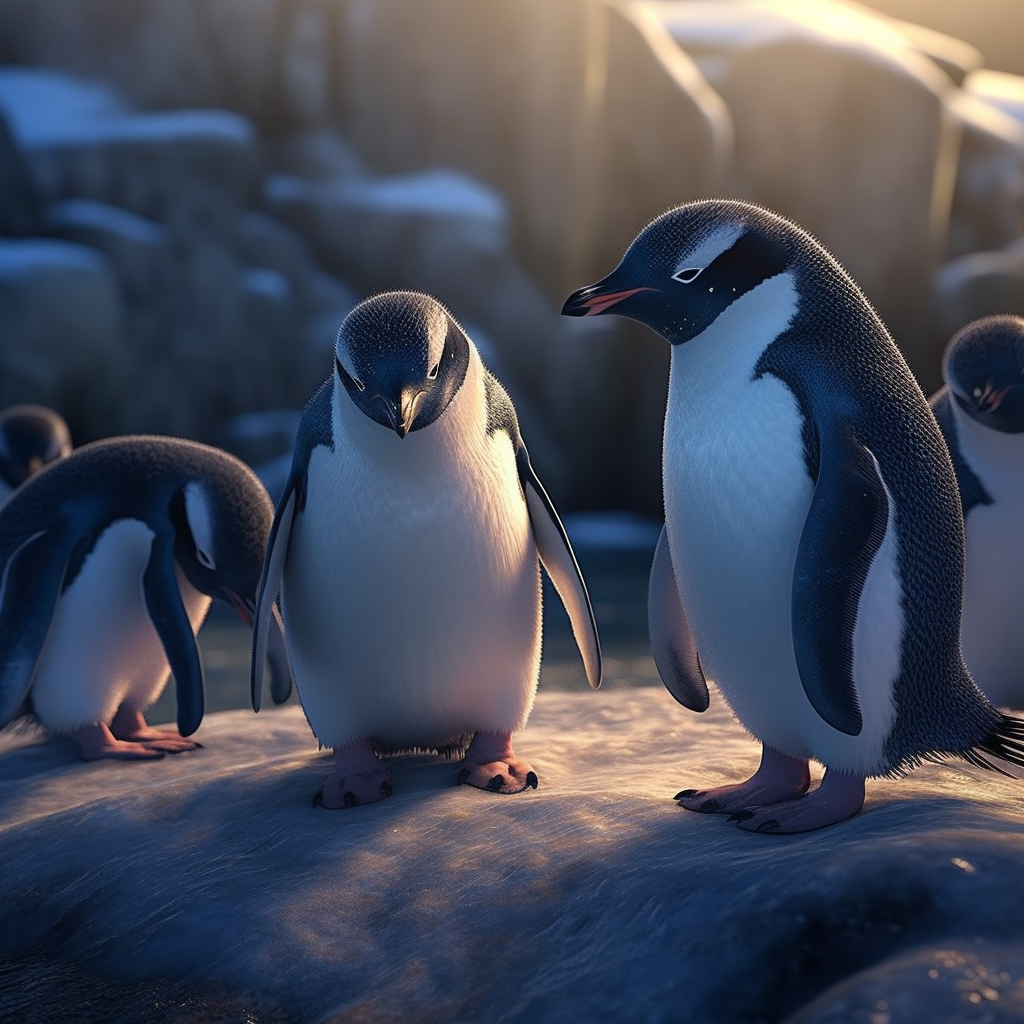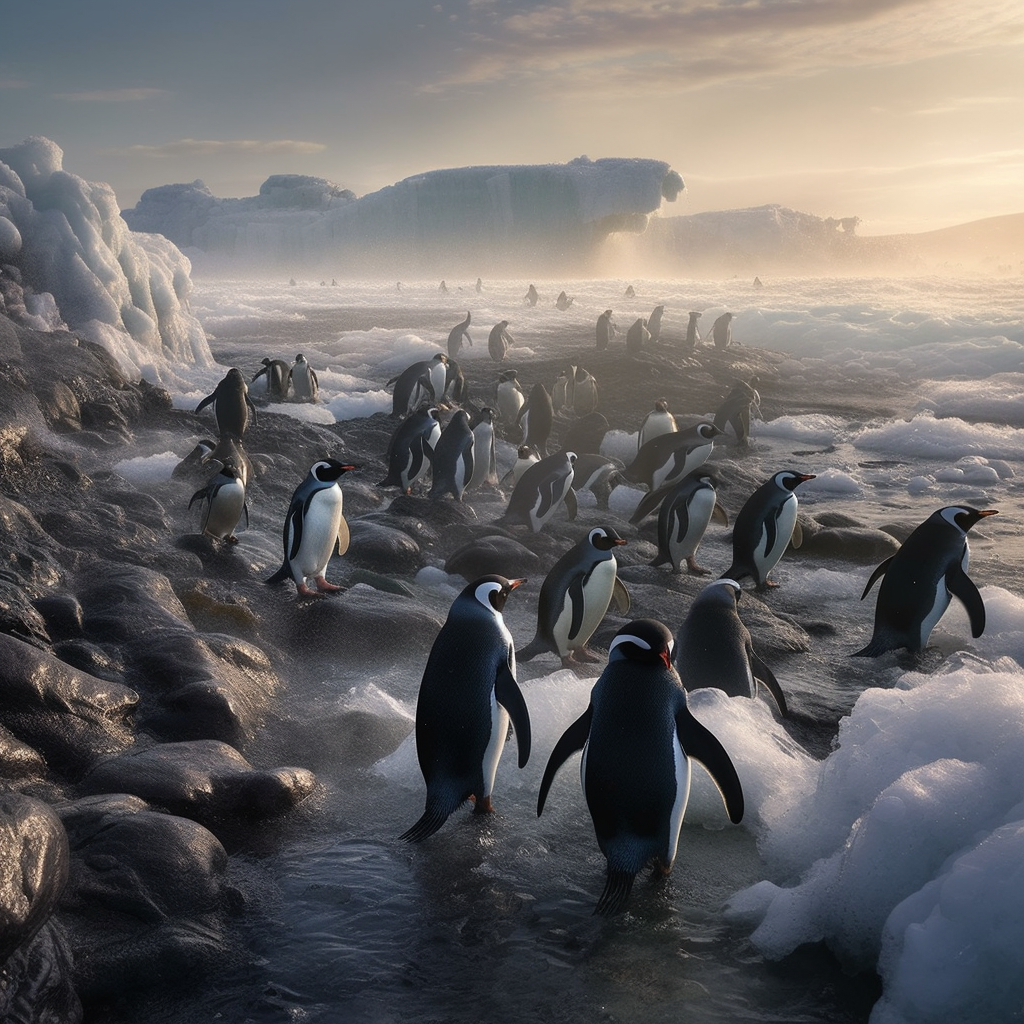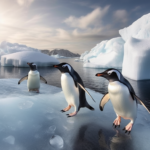Penguins are fascinating creatures that have captured the hearts of many people around the world. These flightless birds are known for their unique adaptations to the harsh environments they inhabit, but one aspect of their behavior that often goes unnoticed is their remarkable ability to work together. In this article, we will explore how penguins collaborate and cooperate with each other, highlighting the various ways in which they rely on teamwork to survive and thrive in their challenging habitats. From hunting for food to raising their young, penguins demonstrate a remarkable level of coordination and cooperation that is truly awe-inspiring. So, let’s dive into the world of penguins and discover how these incredible birds work together to overcome the challenges they face.
Key Takeaways
- Penguins work together in various ways to survive and thrive in their harsh environments.
- They form large colonies to protect themselves from predators and share warmth during extreme weather conditions.
- Penguins take turns to swim in the front, breaking the water‘s resistance for the others, conserving energy for the group.
- They communicate through vocalizations and body language to coordinate hunting, breeding, and other activities.
- Penguins demonstrate remarkable teamwork and cooperation, showcasing the power of collaboration in achieving common goals.
The Social Structure of Penguins
A. Understanding Penguin Colonies
Penguins are fascinating creatures that have evolved to thrive in some of the harshest environments on Earth. One of the most intriguing aspects of their behavior is their ability to work together in large colonies. These colonies can range in size from just a few individuals to several thousand, depending on the species and the availability of resources in their habitat.
Within a penguin colony, there is a well-defined social structure that helps to maintain order and ensure the survival of the group. At the heart of this structure is the concept of teamwork, which is essential for the penguins’ collective success.
B. The Role of Teamwork in Penguin Societies
Penguin collaboration is crucial for their survival, especially in the harsh Antarctic environment where they live. These birds have developed remarkable strategies to work together effectively, allowing them to overcome the challenges they face.
One of the most well-known examples of penguin teamwork is cooperative hunting. Penguins often form groups to forage for food, using their collective strength to increase their chances of success. By working together, they can corral fish into tight schools, making it easier for them to catch their prey.
Communication also plays a vital role in penguin social behavior. Penguins use a variety of vocalizations and body language to convey messages to one another. These signals help them coordinate their movements, whether it’s during a hunting expedition or when defending their territory.
Another area where penguins demonstrate remarkable teamwork is in nest building. Many penguin species engage in nest building cooperation, where pairs of birds work together to construct a suitable nest for their eggs. This collaboration ensures that the eggs are protected from the cold and predators, increasing the chances of successful breeding.
Shared parenting is another aspect of penguin group dynamics. After the female lays her eggs, both parents take turns incubating them and keeping them warm. This shared responsibility allows the parents to take breaks and replenish their energy while ensuring the survival of their offspring.
Penguins also rely on collective foraging to find food efficiently. By swimming in groups, they can create a “net” that helps them catch prey more effectively. This strategy allows them to cover a larger area and increases their chances of finding food.
In addition to these cooperative behaviors, penguins also engage in elaborate mating rituals and form strong bonds within their communities. These social interactions contribute to the overall cohesion and well-being of the colony.
In conclusion, the social structure of penguins is built on teamwork and cooperation. From hunting and communication to nest building and parenting, these birds have developed sophisticated strategies to work together for the benefit of the group. By understanding how penguins collaborate, we can gain insights into the remarkable teamwork found in the animal kingdom.
The Navigational Skills of Penguins
Penguins are remarkable creatures that have adapted to life in some of the harshest environments on Earth. One of the most fascinating aspects of their behavior is their navigational skills. Despite their seemingly clumsy waddle on land, penguins are incredibly adept at finding their way in the vast expanse of the Antarctic.
A. How Penguins Know Where to Go
Have you ever wondered how penguins know where to go when they venture out into the open ocean? It turns out that these birds have a remarkable ability to navigate using a variety of cues. One of the primary ways they find their way is through the use of landmarks. Penguins have an exceptional visual memory and can recognize distinct features of their surroundings, such as rock formations or icebergs, which they use as reference points.
In addition to visual cues, penguins also rely on their sense of hearing. They can detect underwater sounds, such as the calls of other penguins or the movement of prey, which helps them navigate towards food sources or locate their colony. This ability to interpret auditory signals is crucial for their survival in the vast and often featureless ocean.
Another fascinating aspect of penguin navigation is their ability to use the Earth’s magnetic field. Research has shown that penguins have magnetite crystals in their beaks, which act as a sort of natural compass. These crystals align with the Earth’s magnetic field, allowing penguins to orient themselves and maintain a sense of direction even when there are no visible landmarks.
B. The Mystery of Penguins Finding Their Way Home
One of the most intriguing questions about penguin navigation is how they manage to find their way back to their breeding colonies after spending months at sea. These colonies can be located hundreds or even thousands of kilometers away from their feeding grounds, yet penguins are remarkably successful at returning to the same spot year after year.
Scientists believe that penguins rely on a combination of sensory cues and memory to find their way home. They may use the position of the sun or the stars as a reference point, along with their visual memory of the coastline. Penguins also have a keen sense of smell, which may help them detect the unique scent of their colony.
Another theory suggests that penguins may use the Earth’s magnetic field to navigate back to their breeding grounds. By aligning themselves with the magnetic field, they can maintain a consistent heading and follow a specific route back home.
While the exact mechanisms behind penguin navigation are still not fully understood, it is clear that these birds possess remarkable abilities that allow them to navigate the vastness of the ocean and find their way back to their colonies.
In conclusion, penguins are not only adorable creatures but also highly skilled navigators. Through a combination of visual cues, auditory signals, and possibly the Earth’s magnetic field, they are able to find their way in the vast and featureless ocean. The mystery of how they navigate back to their breeding colonies remains a subject of ongoing research, but one thing is certain – penguins are truly remarkable animals.
The Cooperation Among Penguins

Penguins are fascinating creatures known for their ability to work together in various aspects of their lives. From hunting for food to building nests and raising their young, penguins exhibit remarkable teamwork and cooperation. In this section, we will explore how penguins work together, why they choose to do so, and the mutual benefits they derive from their collaboration.
A. How Penguins Work Together
Penguins are highly social animals that live in large colonies, sometimes consisting of thousands of individuals. Within these colonies, penguins exhibit intricate group dynamics and engage in cooperative behaviors. One of the most notable examples of penguin collaboration is seen in their hunting techniques.
Cooperative hunting is a common practice among penguins, especially when it comes to catching fish. Penguins swim in groups, herding schools of fish together, and taking turns to dive and catch their prey. This strategy allows them to maximize their chances of success while minimizing the energy expended by each individual.
Penguins also rely on effective communication to coordinate their actions. They use a combination of vocalizations, body postures, and visual displays to convey information to their group members. This communication helps them synchronize their movements, maintain group cohesion, and ensure efficient hunting.
Another aspect of penguin cooperation can be observed in their nest-building activities. Penguins build nests out of stones, and they often work together to gather the necessary materials. They take turns collecting stones and arranging them in a circular pattern to create a comfortable and protective nest for their eggs.
B. Why Penguins Choose to Work Together
Penguins choose to work together primarily because it increases their chances of survival and success. By cooperating, they can overcome the challenges posed by their harsh Antarctic environment and the scarcity of food.
In the case of hunting, cooperative behavior allows penguins to catch larger prey and secure a more substantial food source for the entire group. By working together, they can herd fish into concentrated areas, making it easier for each individual to catch their share. This collaborative hunting strategy ensures that all members of the group have access to food, reducing competition and increasing overall efficiency.
Additionally, by building nests together, penguins can protect their eggs and young from predators and harsh weather conditions. The collective effort in nest building ensures that the nests are sturdy and well-insulated, providing a safe haven for their offspring.
C. The Mutual Benefits of Penguin Cooperation
The cooperation among penguins not only benefits the individuals involved but also contributes to the overall survival and well-being of the entire colony. By working together, penguins can achieve goals that would be challenging or impossible to accomplish individually.
For example, penguins engage in a behavior known as huddling, where they gather in large groups to conserve heat and shield themselves from the cold Antarctic winds. By huddling together, penguins can maintain their body temperature and reduce heat loss, increasing their chances of survival in extreme weather conditions.
Furthermore, penguins exhibit shared parenting, where both males and females take turns incubating the eggs and caring for the chicks. This cooperative parenting strategy allows penguins to share the responsibilities of raising their young, ensuring their survival and growth.
In conclusion, penguins are remarkable examples of teamwork and cooperation in the animal kingdom. Their collaborative hunting techniques, nest-building activities, and shared parenting contribute to the overall success and survival of their colonies. By working together, penguins are able to overcome the challenges of their environment and thrive in one of the harshest regions on Earth.
The Survival Strategies of Penguins
A. How Penguins Work Together to Survive
Penguins are fascinating creatures that have developed remarkable strategies to survive in their harsh Antarctic environment. These flightless birds have evolved a strong sense of community and rely on teamwork to overcome the challenges they face. Let’s explore how penguins work together to ensure their survival.
1. Cooperative Hunting
One of the most impressive displays of penguin collaboration is their cooperative hunting behavior. Penguins often form groups to forage for food in the ocean. By working together, they can effectively corral fish and other prey, making it easier for each individual to catch a meal. This cooperative hunting strategy increases their chances of success and ensures that all members of the group are well-fed.
2. Nest Building Cooperation
Another way penguins demonstrate their teamwork skills is through nest building. Penguins construct nests using rocks, pebbles, and other materials found in their environment. They work together to gather these materials and build their nests, which provide protection and insulation for their eggs and chicks. By collaborating in nest building, penguins create a sense of community and ensure the survival of their offspring.
3. Shared Parenting
Penguins are known for their unique approach to parenting. Both male and female penguins take turns incubating their eggs and caring for their chicks. This shared parenting allows each parent to take breaks to feed and replenish their energy while the other stays behind to protect and nurture the young. By working together in this way, penguins ensure the survival and well-being of their offspring.
B. The Role of Teamwork in Penguin Survival
Teamwork plays a crucial role in the survival of penguins. By working together, these birds are able to overcome the challenges posed by their icy habitat and thrive in a harsh environment. Let’s delve deeper into the importance of teamwork in penguin survival.
1. Penguin Group Dynamics
Penguins live in large colonies, which can consist of thousands of individuals. Within these colonies, they establish a social structure that allows them to work together efficiently. Each penguin has a specific role within the group, whether it’s hunting, nesting, or protecting the young. This division of labor ensures that all essential tasks are carried out, contributing to the overall survival of the colony.
2. Huddling for Warmth
One of the most iconic displays of penguin teamwork is their huddling behavior. When the temperature drops, penguins gather in large groups and huddle together for warmth. By forming a tight-knit circle, they create a microclimate that helps them withstand the extreme cold. The penguins on the outer edge of the huddle take turns moving to the center, allowing each individual to benefit from the warmth generated by the group.
3. Collective Foraging
In addition to cooperative hunting, penguins also engage in collective foraging. They swim in groups, diving and surfacing together in search of food. This synchronized behavior helps them locate prey more efficiently and increases their chances of finding an abundant food source. By working together in their foraging efforts, penguins maximize their chances of survival in a challenging environment.
In conclusion, penguins have developed remarkable strategies to work together and ensure their survival in the Antarctic. Through cooperative hunting, nest building cooperation, shared parenting, group dynamics, huddling for warmth, and collective foraging, these birds demonstrate the power of teamwork in the animal kingdom. Their ability to collaborate and support one another is truly awe-inspiring and allows them to thrive in one of the harshest environments on Earth.
The Unique Case of Emperor Penguins

A. How Emperor Penguins Work Together
Emperor penguins are known for their incredible teamwork and cooperative behavior. These fascinating creatures live in the harsh conditions of the Antarctic, where temperatures can drop to as low as -40 degrees Celsius. To survive in such extreme conditions, emperor penguins have developed remarkable strategies for working together.
One of the most remarkable aspects of emperor penguin collaboration is their cooperative hunting. These birds rely on their collective efforts to catch prey, primarily fish and squid. By working together, they increase their chances of success and ensure that each member of the group gets enough food to survive.
Communication is key in penguin society. Emperor penguins use a variety of vocalizations and body language to convey messages to one another. These signals help them coordinate their movements, whether it’s during a hunting expedition or while protecting their nests.
Another example of cooperation among emperor penguins is nest building. During the breeding season, male penguins work together to construct nests made of stones. By collaborating, they create a safe and warm environment for their eggs, protecting them from the freezing temperatures of the Antarctic.
B. The Importance of Cooperation in Emperor Penguin Colonies
Cooperation is vital for the survival of emperor penguin colonies. These colonies can consist of thousands of individuals, and each member plays a crucial role in maintaining the overall well-being of the group.
Shared parenting is a unique feature of emperor penguins. After laying their eggs, female penguins transfer them to the males, who then incubate them by keeping them warm on their feet. This shared responsibility allows the females to go on a long journey to find food, while the males ensure the eggs stay protected and warm.
Penguin group dynamics are also essential for survival. When the temperatures drop even further during the winter months, emperor penguins gather in large groups called huddles. By huddling together, they conserve heat and reduce the impact of the harsh weather conditions. The penguins take turns being on the outer edge of the huddle, shielding the others from the cold winds.
Collective foraging is another cooperative behavior observed in emperor penguins. They swim in groups, taking turns diving into the water to catch prey. This strategy allows them to cover a larger area and increases their chances of finding food.
In addition to these survival tactics, emperor penguins also exhibit cooperative behaviors during mating rituals. Males engage in elaborate displays to attract females, and they often form groups to compete for the attention of a female. This social structure ensures that mating is fair and allows for genetic diversity within the colony.
In conclusion, emperor penguins are a remarkable example of teamwork and cooperation in the animal kingdom. Their ability to work together in challenging environments is essential for their survival. From hunting and communication to nest building and parenting, these birds demonstrate the power of collaboration. By understanding the unique social structure and behaviors of emperor penguins, we can gain valuable insights into the importance of cooperation in our own lives.
The Helping Nature of Penguins

Penguins are fascinating creatures that have evolved to thrive in some of the harshest environments on Earth. One of the most remarkable aspects of their behavior is their ability to work together in order to increase their chances of survival. In this section, we will explore how penguins help each other and the impact of mutual aid on penguin communities.
A. How Penguins Help Each Other
Penguins are highly social animals, and their ability to collaborate and communicate with one another is crucial for their survival. One of the ways in which penguins help each other is through cooperative hunting. When hunting for fish, penguins often form groups and swim together, herding the fish into a tight ball. This makes it easier for them to catch their prey, as the fish are less likely to escape.
Another way in which penguins demonstrate their cooperative nature is through nest building. Penguins build nests out of rocks, and they often work together to gather the materials needed for construction. They take turns finding and carrying rocks, ensuring that each member of the group has a chance to rest and conserve energy. This cooperative effort not only strengthens the bond between penguins but also helps to protect their eggs and chicks from predators.
B. The Impact of Mutual Aid on Penguin Communities
The mutual aid and cooperation displayed by penguins have a profound impact on their communities. Penguin colonies, which can consist of thousands of individuals, rely on teamwork and collaboration for their survival. By working together, penguins are able to share the responsibilities of parenting, foraging for food, and protecting their territory.
One of the most well-known examples of penguin cooperation is huddling. Penguins gather together in large groups, huddling closely to keep warm in the frigid Antarctic temperatures. By huddling, penguins are able to conserve body heat and reduce the risk of hypothermia. The penguins on the outer edges of the huddle take turns moving to the center, ensuring that each member of the group gets a chance to warm up.
Collective foraging is another example of how penguins work together to benefit the entire community. When searching for food, penguins swim in groups, taking turns diving and catching fish. This strategy allows them to cover a larger area and increases their chances of finding enough food to sustain the entire colony.
In addition to survival tactics, penguins also rely on cooperation during mating rituals. Male penguins often form groups and engage in elaborate displays to attract a mate. By working together, they increase their chances of finding a suitable partner and successfully reproducing.
In conclusion, penguins are remarkable creatures that have developed sophisticated social structures and behaviors to ensure their survival in challenging environments. Their ability to work together through cooperative hunting, nest building, huddling, collective foraging, and mating rituals is a testament to the power of teamwork in the animal kingdom. By helping each other, penguins create strong and resilient communities that are able to thrive in even the most extreme conditions. Conclusion
In conclusion, penguins are fascinating creatures that have evolved unique ways to work together and thrive in their harsh environments. Through cooperative breeding, huddling, and synchronized swimming, these remarkable birds demonstrate the power of teamwork. By sharing the responsibilities of incubating eggs, protecting against predators, and navigating the treacherous waters, penguins exemplify the importance of collaboration and unity. Their ability to communicate, coordinate, and support one another is truly remarkable and serves as an inspiration for us humans. As we continue to study and learn from these incredible animals, we gain a deeper appreciation for the wonders of nature and the strength that comes from working together. So, let’s take a page from the penguin playbook and remember that by working together, we can achieve great things.
Frequently Asked Questions
How do penguins know where to go?
Penguins have an innate sense of direction that helps them navigate the vast Antarctic landscapes. They use the position of the sun and other environmental cues to find their way. This is crucial for their survival as they often travel long distances for foraging and returning to their colonies.
Why do penguins work together?
Penguins work together for a variety of reasons, primarily for survival. This Antarctic teamwork involves cooperative hunting, nest building, shared parenting, and collective foraging. Working together increases their chances of finding food, protecting their young, and surviving harsh weather conditions.
How do emperor penguins work together?
Emperor penguins exhibit a high level of Penguin collaboration. They huddle together to withstand the harsh Antarctic winters, share parenting duties, and take turns to go foraging. This behavior helps them conserve energy and increase the survival rate of their chicks.
How do penguins help each other?
Penguins help each other in many ways. They engage in cooperative hunting where they work together to herd fish, making it easier to catch their prey. They also share parenting duties, with both parents taking turns to incubate the eggs and feed the chicks. During harsh weather, they huddle together to share warmth.
What penguins work together?
All species of penguins exhibit some form of social behavior and cooperation. However, Emperor and Adélie penguins are particularly known for their high level of collaboration, which includes huddling together for warmth, cooperative hunting, and shared parenting.
How do penguins work together to survive?
Penguins work together to survive in several ways. They engage in collective foraging and cooperative hunting to increase their chances of finding and catching food. They huddle together to share warmth and protect themselves from harsh weather. They also share parenting duties to ensure the survival of their chicks.
How do penguins find their way home?
Penguins have an impressive ability to navigate their way home over long distances. They use environmental cues and possibly the Earth’s magnetic field to find their way back to their colonies. This is crucial for penguins as they often travel long distances for foraging.
How does penguin social structure contribute to their survival?
The social structure of penguins plays a significant role in their survival. They live in large colonies, which provides protection from predators. Their cooperative behavior, such as shared parenting and collective foraging, increases their chances of finding food and raising their chicks successfully.
How does teamwork in the animal kingdom manifest in penguins?
Penguins are a prime example of teamwork in the animal kingdom. They engage in cooperative hunting, collective foraging, and shared parenting. They also huddle together to share warmth during harsh weather. This level of cooperation and teamwork greatly enhances their chances of survival.
What are some unique aspects of penguin group behavior?
Penguin group behavior includes a variety of unique aspects. They engage in cooperative hunting, where they work together to herd and catch fish. They also share parenting duties, with both parents taking turns to incubate the eggs and feed the chicks. During harsh weather, they huddle together to share warmth. These behaviors are not only unique but also crucial for their survival.




